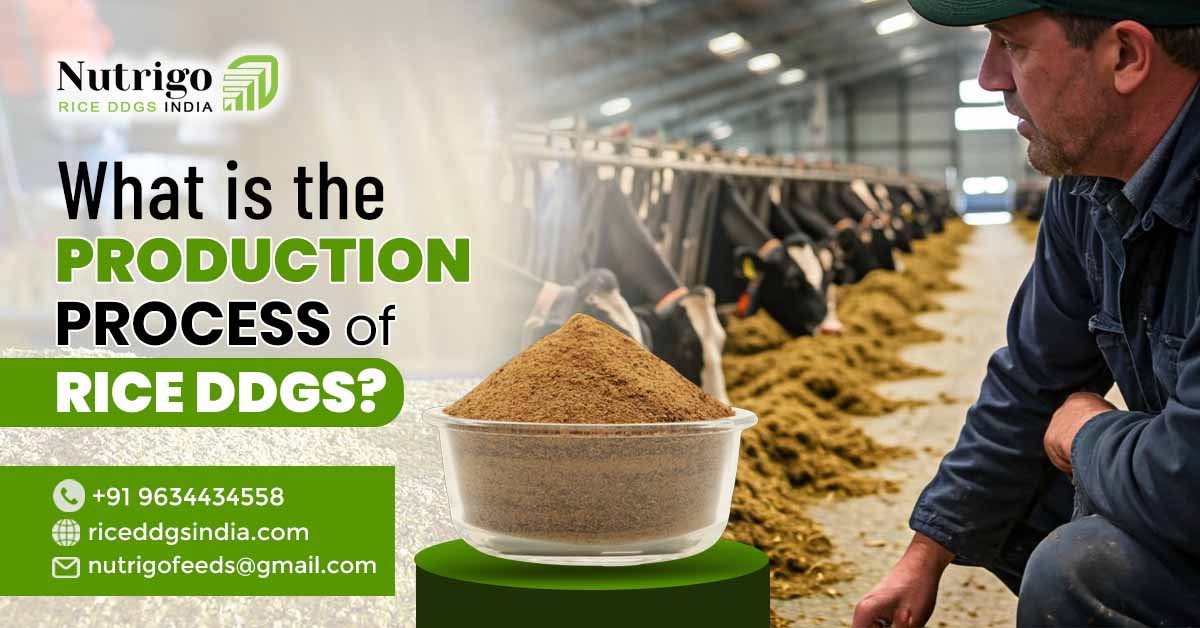Rice distillers dried grains with solubles (DDGS) is a byproduct originating from the process of making ethanol using rice as a raw material. It is considered very important because it is a healthy food for different animals.
It results from the drying of the leftover solid materials that are left after rice has been fermented. Protein and energy in abundance makes Rice DDGS a useful component for animal feed. The topic under discussion in this blog will be the Rice DDGs Production Process In India
Rice DDGs Production Process In India
1. Rice Milling
Rice Polishing: This process starts with polishing rice, which turns brown rice into white rice by taking off the outer layers called bran and germ.
2. Fermentation
Preparation: The main ingredient, usually rice or rice bran, is ground into a fine powder to help the enzymes work better.
Enzymatic Hydrolysis: Enzymes like alpha-amylase and glucoamylase are added to ground rice to turn the starch into sugars that can be fermented, mostly glucose.
3. Distillation
Separation: The fermented mass (beer) consists of three components-alcohol, water and small residues including unfermented grains, proteins and fibres. It is taken to the distillation machine where solid residues and water were already separated from the ethanol.
Ethanol Recovery: Ethanol is gathered and cleaned up more, while the leftover solids and liquid are treated again.
4. Centrifugation
Solid-Liquid Separation: The stillage is put into machines called centrifuges to separate the solid part (wet distillers grains) from the liquid part (thin stillage).
Concentration: The liquid leftover from processing is usually thickened using machines to make a syrup that has dissolved substances in it.
5. Drying
Drying Process: The wet distiller’s grains and syrup are mixed together and dried using machines like rotary drum dryers to take out the water.
Managing Drying Conditions: It’s important to carefully control the drying temperature and time to make sure the DDGS has the right moisture level and nutrition.
6. Checking Quality and Packing
Nutrient Testing: The finished DDGS product is checked for its nutrient content, like protein, fibre, fat, and moisture, to make sure it is of good quality.
Packaging: Quality has been ensured and after, the DDGS rice was cooled, dried, and packed in proper containers and or large bags for storage as well as transportation.
Important Points to Think About In Rice DDGs Production Process In India
Enzyme Efficiency: The yield and quality of ethanol production as well as the animal feed known as DDGS is affected by the efficiency of the enzymes.
Fermentation Conditions: Keeping the right temperature, acidity, and time is important for making good ethanol and high-quality DDGS.
Drying Process: Drying correctly is important to keep the nutrients and make sure the product lasts a long time without getting mouldy or spoiled.
Nutrient Retention: It is important to make sure that the drying process keeps as many nutrients as possible, especially proteins and amino acids, to produce good-quality DDGS.
Advantages of Rice DDGS
High Protein Content: On dried form Rice DDGS contains a significant amount of protein ranging from 25-30% in dry form.
High Energy Source: Rice DDGS is a feed component that offers a high value of energy in its sources. It contains fat of about 10-12% and 65-70% of total digestible nutrients when dried.
Affordable: It is an economical option that is cheaper as compared to regular animal feeds like corn & soybean meal.
Eco-Friendly: Manufacturing Rice DDGS is good for the environment because it uses left-out materials from manufacturing ethanol.
Indian Rice DDGs Export Market
The Indian Rice DDGS Export Market has grown a lot because more people around the world want animal feed and biofuels become more popular. The Indian Rice DDGS Export Market country’s plans to boost farming and make shipping goods easier have made it more competitive. Important places for Indian DDGS are Southeast Asia, the Middle East, and some areas of Africa, where there is a big demand for cheap and healthy animal feed. As people around the world focus more on sustainability, selling rice DDGS helps grow the economy and supports environmental aims by using resources more efficiently.
Conclusion
Rice DDGs Production Process In India includes a few important steps: milling the rice, fermenting it, distilling the liquid, spinning it to separate the parts, drying it, and checking for quality. Each & every step is important for making a good, nutritious feed ingredient that helps to keep different animals healthy. At Rice DDGS India, we use advanced technology and quality control to manufacture the best Rice DDGS for our customers and their animals.
Frequently Asked Questions (FAQs)
Q1 – How is Rice DDGS made?
Ans – Rice milling: The rice grains outermost layer is removed very carefully.
Starch extraction: The ground rice is mixed with water or special substances to get the starch out, while the protein, fibre, and other nutrients stay behind.
Drying: The material that is left out from getting starch is dried which is further used to remove moisture & creates Distillers Dried Grains with Solubles (DDGS).
Q – Are there any quality rules for manufacturing Rice DDGS in India?
Ans: The Bureau of Indian Standards (BIS) has made specific rules for DDGS about how much moisture, protein, fibre, and other things it should have. Manufacturers need to follow these rules to make sure their Rice DDGS products are of good quality.
Contact Details:
Company Name: Rice DDGS India
Address: #455, Sector-7, Panchkula, Haryana, India – 134108
Phone: +91 9634434558
Email: nutrigofeeds@gmail.com


